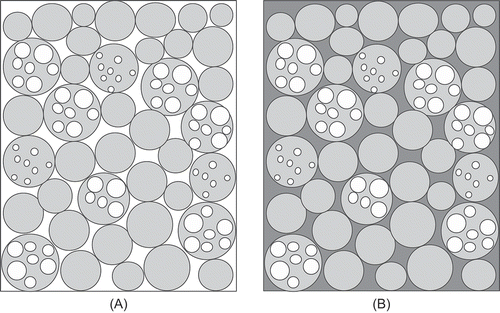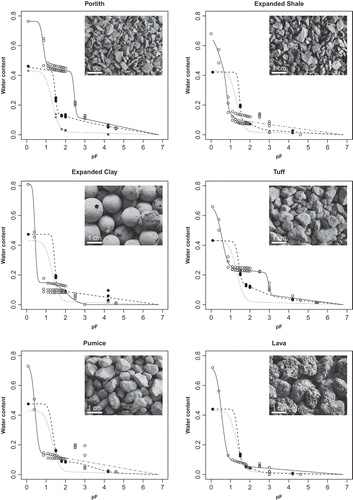Figures & data
Figure 1. Graphic representation of the calculated porosities. The pores are represented in white. Two main pore domains are observed: the pores inside the CPMs, or intra-particle porosity (), as well as the voids among particles, or inter-particle porosity (
). The (A) total porosity (
) accounts for both and it was calculated by
. The (B) intra-particle porosity (
) excludes the
and was calculated by
.

Table 1. General characteristics of the CPMs and the sand. EC = electric conductivity, = bulk density,
= apparent density,
= total porosity and
= intra-particle porosity (only the porous of the materials, without the surroundings).
Figure 2. Observed water retention data and fitted retention curves for the sand, composite samples and pure CPMs. Sand: () measured, (
) fitted, sand mixed with CPM: (
) measured, (- -) fitted, CPMs: (
) measured, (—) fitted (uncertainty is symbolized by - -). The graph of porlith (upper left) shows the measured points for sand. In the graphs can be observed the inflections of the air entry point(s), and the water held in the range of available water content (AWC) from pF 1.8 to pF 4.2.

Table 2. Available water capacity (AWC), field capacity (FC), and parameters of unimodal (applied just for sand) and bimodal Peters–Durner–Iden model (2015) fitted to the data of pure materials and the materials mixed with sand.
Figure 3. Volumetric water content of the CPMs intra-particle porosity () held at matric force of pF 1.8 (considered as field capacity) and AWC (cross hatched columns) when embedded in sand compared when embedded in silt. The pebbles of the CPMs were embedded in silt to ensure capillary contact when measured with ceramic tension plates at matric forces ranging from 1.8 to 3. Therefore, the water content of the pure sand and silt was obtained and subsequently subtracted with EquationEquation (1)
(1)
(1) . The result is the water stored specifically inside the pebbles.
![Figure 3. Volumetric water content of the CPMs intra-particle porosity ( ϕ i n t r a ) held at matric force of pF 1.8 (considered as field capacity) and AWC (cross hatched columns) when embedded in sand compared when embedded in silt. The pebbles of the CPMs were embedded in silt to ensure capillary contact when measured with ceramic tension plates at matric forces ranging from 1.8 to 3. Therefore, the water content of the pure sand and silt was obtained and subsequently subtracted with EquationEquation (1)(1) θ C P M = [ θ t − ( ( 1 − X ) x θ s a i ) / X ] x ( 1 − ϕ i n t e r ) (1) . The result is the water stored specifically inside the pebbles.](/cms/asset/29febddc-d239-4320-a0a5-bc29d3c0b531/tssp_a_1447293_f0003_b.gif)
